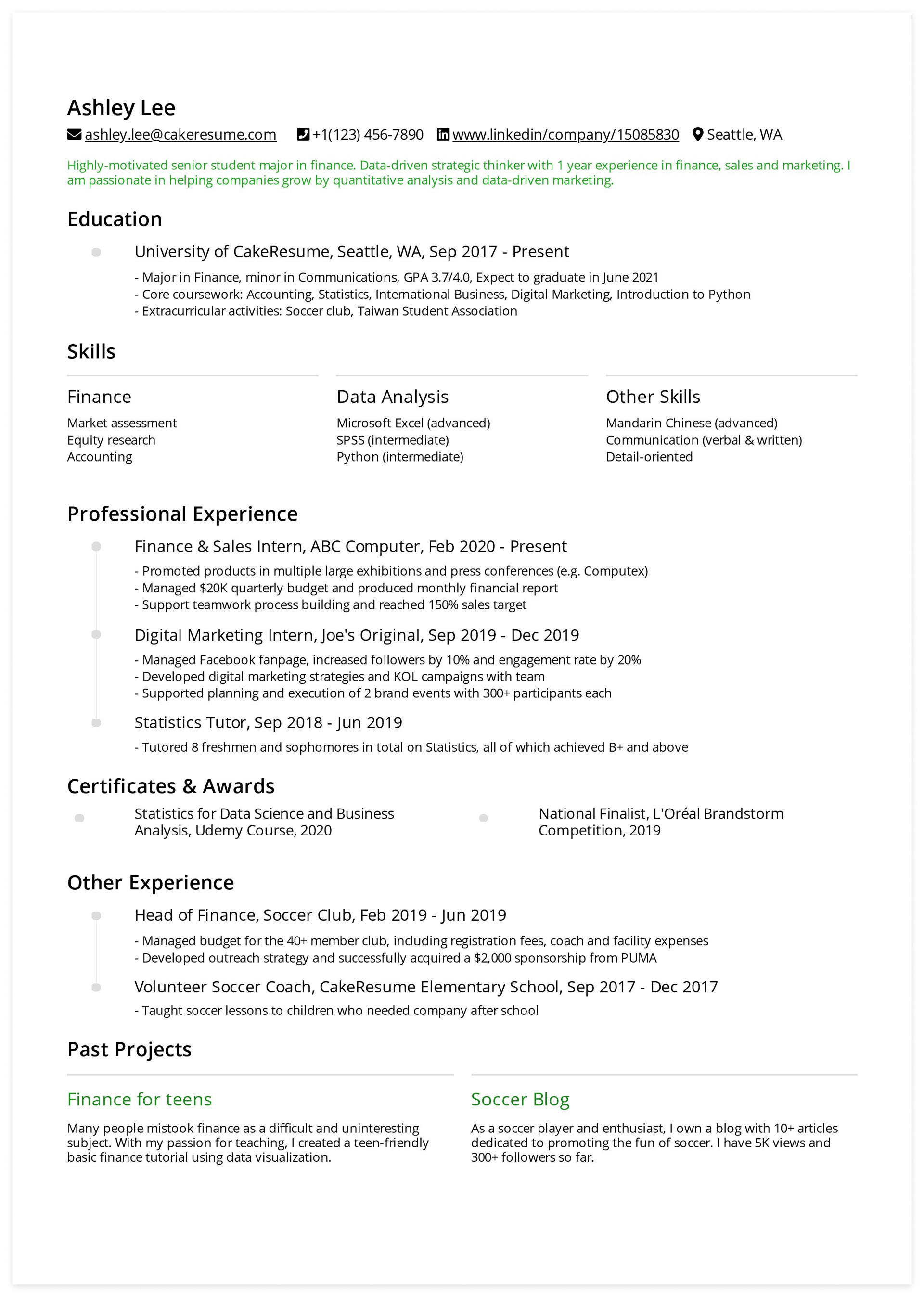College Students: Resume Examples, Formats & Tips
You are a student with possibly no work experience at all, but you’re looking for a job or an internship. This might be your first time writing a resume. It is indeed challenging - how can you convince a potential employer to trust your professional ability when you lack professional experience?
Believe it or not, every CEO starts with zero experience. You are still going to win a job or an internship as long as you have an impressive resume. Follow this article to learn how.
Overview
1. What should be on a college student’s resume?
2. How to choose the right resume format?
What should be on a college student’s resume?
1. Contact information
Always remember to have your contact information clear, accurate and at the top of the page. You want your employer to know how to reach you when they’re impressed. Here’s a checklist:
- Full name
- Email address
- Phone number
- LinkedIn profile (optional but recommended)
- If you have moved or traveled, consider including your city/state name. A detailed address is not necessary though.
2. Resume objective/summary
If you’re applying for a popular position, the HR will likely spend no more than 7 seconds on your resume before deciding if you’re worth considering. That's why a resume objective/summary is so important.
A resume objective/summary summarizes who you are as a candidate and states your career goal. You want the HR to take only 3 seconds to get a big picture of who you are and to understand that you might be a good fit.
Quick tips for a resume summary
- Concise: If you have numbers, share it. If you can narrow down your area of interests or career goals, do so. Be as specific as possible; HRs are often tired of general and broad terms such as “problem-solver”, “self-starter”, and “leader”.
- Short: Stick to 2 to 4 sentences. You want the HR to grasp who you are in seconds instead of losing patience.
- Relevant: Speak to the job description. If you’re applying for a bookkeeper, don’t talk about how you love to travel. If you’re looking to join a startup, talk about how you are creative and innovative. If you’re applying for a copywriting internship, talk about how much you read and write.
- Write your resume objective/summary AFTER you’ve finished the rest of your resume. Scan through all your experiences and ask yourself, “Who is this person?” “What might be their goal?”

3. Education
As a student, your education experience is usually the first item on the list. To make your education stand out, be sure to include relevant details, including:
- University name
- Location
- Graduation date / expected graduation date
- Degree (including any minors)
- A short list of relevant coursework
- GPA (only if it’s impressive)
- Awards or honors (if applicable)
- Student clubs or organizations (optional)
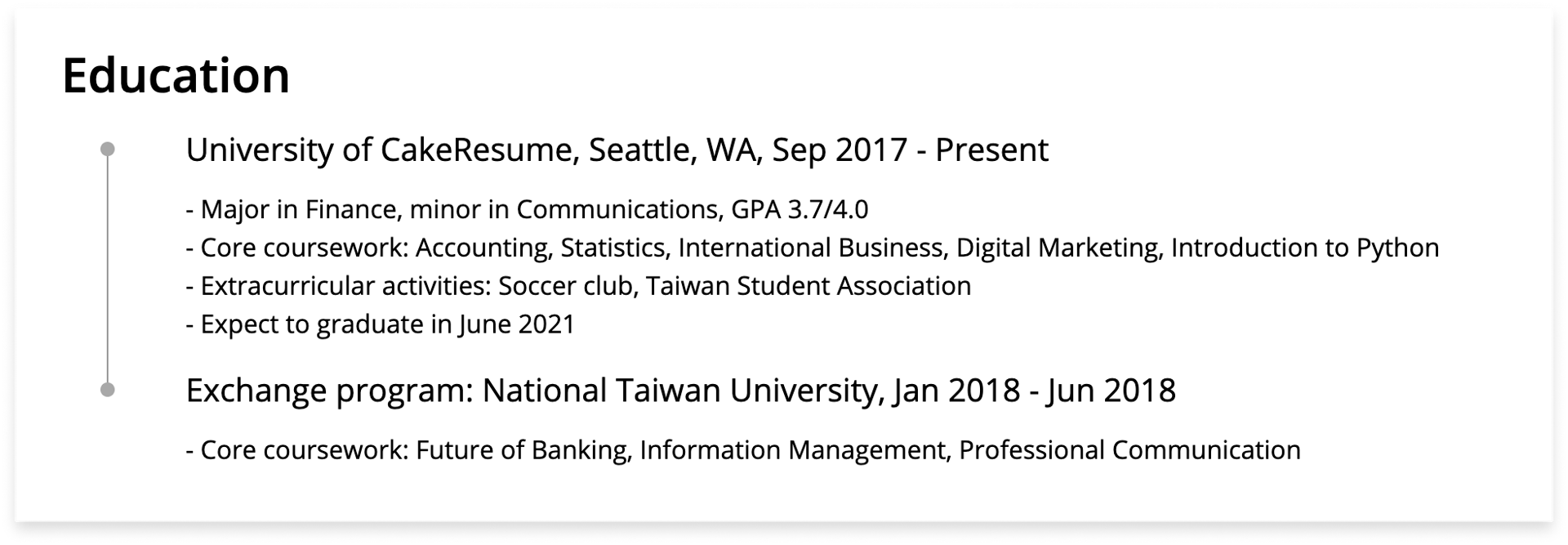
4. Skills
Although you don’t have solid work experience yet, you likely learned valuable skills in school. Both hard and soft skills are highly valued at work, so you definitely want to take this section as a chance to market your strengths.
Also, do you know that recruiters are increasingly relying on AI to scan through job applications? AI can easily kick you out if you lack essential keywords from the job description. Remember to look through the job description closely and highlight the relevant skills you have in this section.
Finally, explain your level of those skills with progress bars or words such as basic, intermediate, or advanced. Don’t lie! HRs and supervisors will eventually find out.
Popular hard skills:
- Office softwares (e.g. Microsoft Office, Google Drive, Slack)
- Programming (e.g. Python, R, C++, HTML, PHP)
- Design softwares (e.g. Photoshop, Sketch, Illustrator)
- Analytic tools (e.g. Google Analytics, Tableau, SPSS)
- Domain knowledge (e.g. public relations, graphic design, fintech, macroeconomy)
- Foreign languages
Popular soft skills:
- Teamwork
- Written and verbal communication
- Critical thinking
- Leadership
- Problem solving
- Time management
- Public speaking

5. Internships, part-time jobs and volunteer works
You don’t have full-time work experience, but you still have valuable experiences that are worth mentioning. Separate different types of work to multiple sections if you have more than one item in each section, or integrate them into a “Relevant Experience” section.
- Internships: Internships are usually the closest to work experience. Use bullet points and active verbs to explain what you did specifically and what key results you’ve achieved.
- Part-time jobs: Even if the part-time works you did (e.g. tutoring, clerks) are not directly related to the job you’re applying for, those experiences can showcase some soft skills such as communication and time management. Remember to keep them short and put them at the bottom of the list.
- Volunteering: Volunteer works are valuable in many ways. If the work you did or the organization you worked with is relevant to the position or company you are applying for, it can possibly count as internships. If not, it still proves your soft skills, passion and personality. After all, every employer wants an employee who is willing to give and share. Remember to explain specifically what you did as a volunteer and what you’ve learned from it.
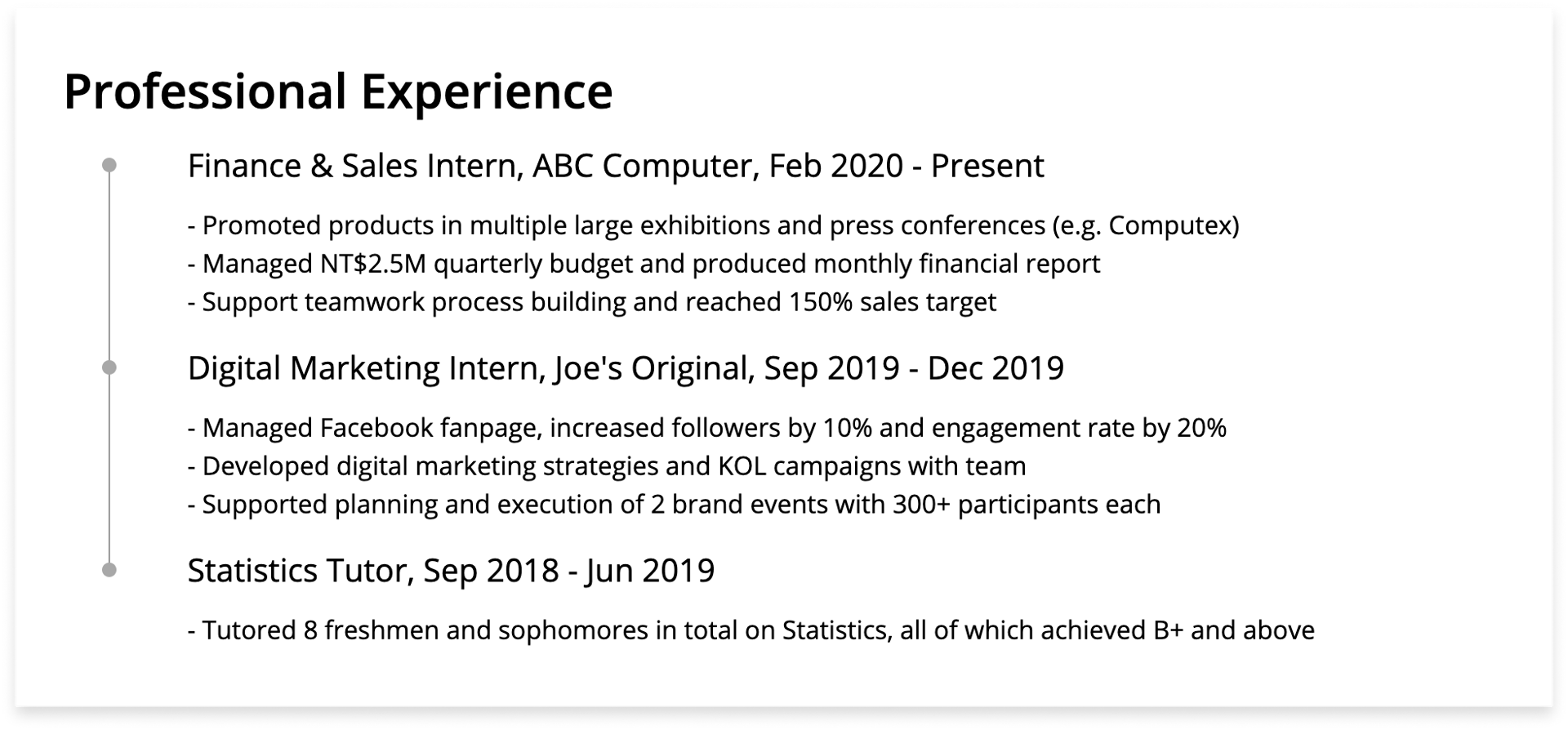
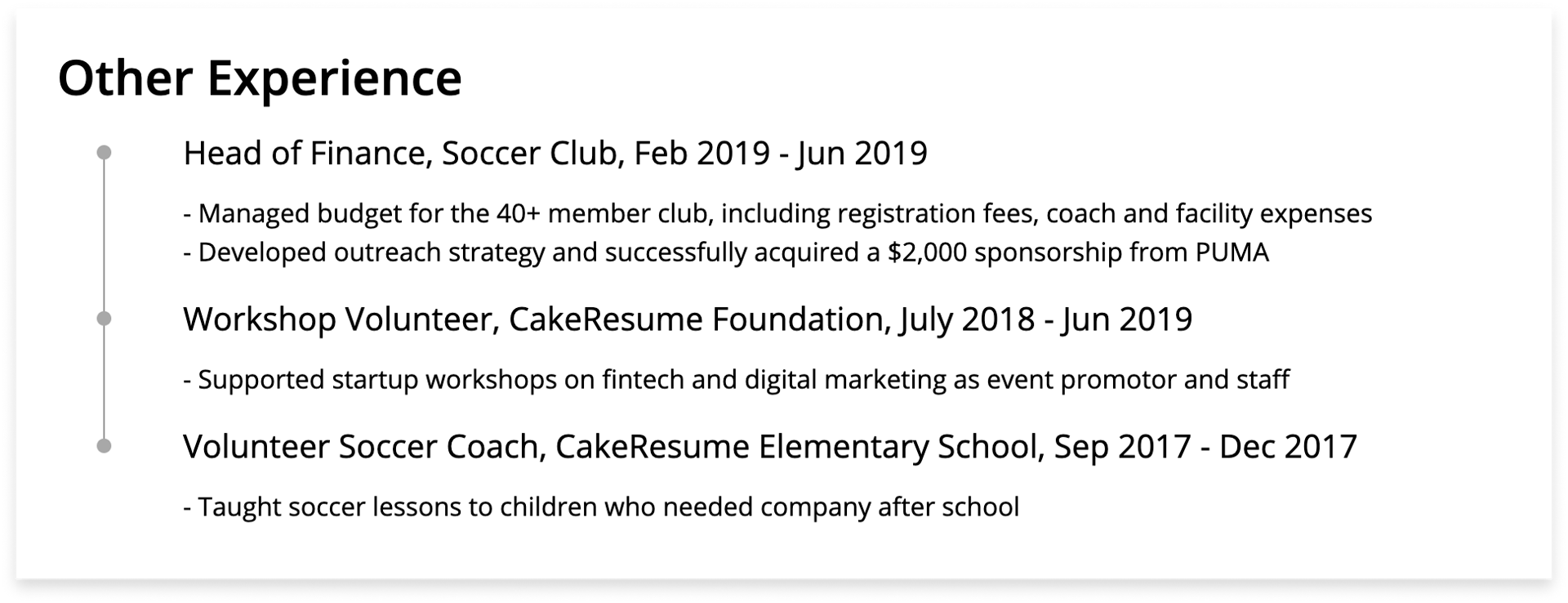
6. Certifications and awards
If you have certifications relevant to the position, make sure to let employers know! Certifications prove your skills and show that you treat your future career seriously. Popular certifications include Project Management Professional (PMP), Cisco Certified Network Associate (CCNA), Google Certifications (Analytics, Ads etc.) and more. If you’ve earned an online course certificate that’s relevant to the position, be sure to include it too!
If you have received multiple awards or scholarships, highlight them in an individual section. If your awards are closely related to academic performance such as dean's list and magna cum laude, put them in the education section.

7. Projects
Many job seekers forget this section, but providing projects is the perfect way to showcase yourself and make an impression.
As a college student, you likely went through multiple school projects, or work on side projects with classmates. Those projects can often show your creativity, analytical skills, critical thinking and even presentation skills. While you don’t necessarily have to build a portfolio, you can polish 2~3 of your works, make it visually attractive, and share a viewable link on your resume.
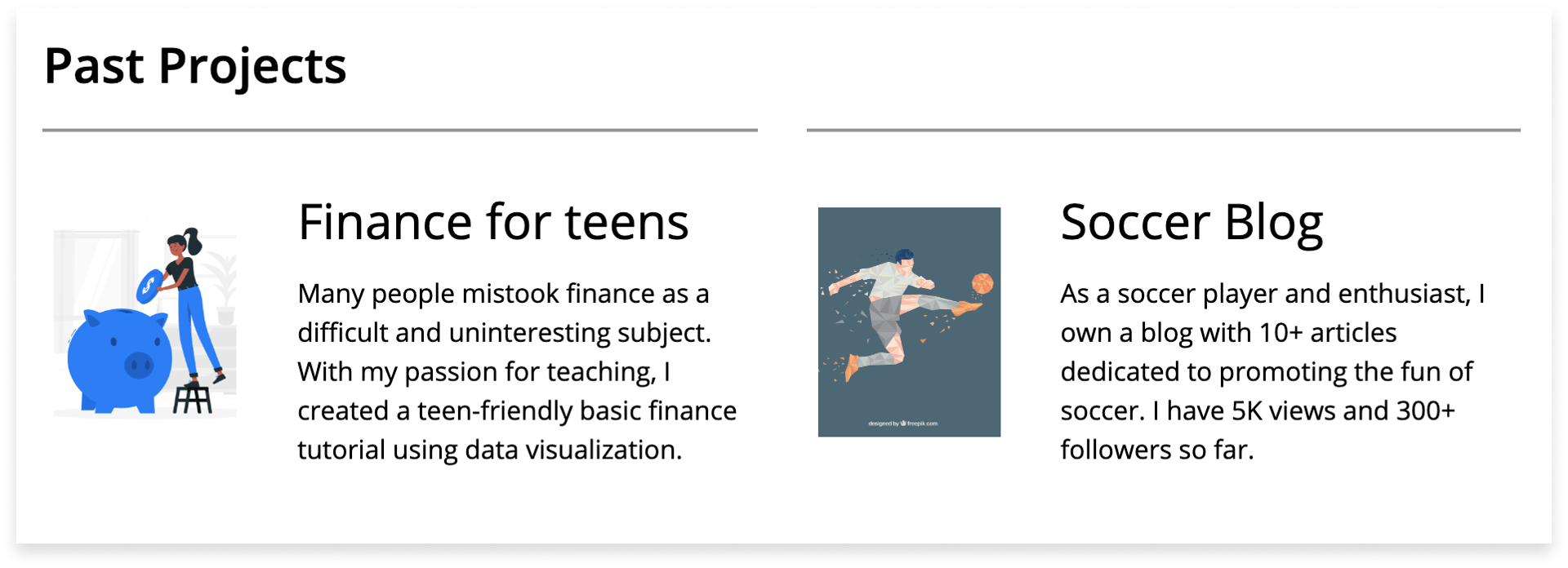
Still got space? Try including a short section for your hobbies or extracurricular activities just to add a little personal touch. Keep it short and sweet!
Further reading: Top 6 Resume Mistakes for Recent Graduates
How to choose the right resume format?
First of all, there is no one right format. Before choosing the right resume format for you, take a close look at your experience, job field, and skill set.
1. Order
3 Common Resume Formats
- Chronological (Reverse-chronological) resume: A chronological resume lists the most recent experience first and then backward through time. This helps recruiters and hiring managers see your highest-level achievements and most timely experience first. It is the most traditional and straightforward option.
- Functional resume: Instead of listing work history one by one, a functional resume categorizes by professional skills across each job. This is only suitable for career changers and those who have large gaps between each job.
- Hybrid resume: As you can imagine, a hybrid resume combines the best of chronological resume and functional resume. You can highlight professional skills and accomplishments in an individual section but still list work history in a chronological order.
As a college student, you don’t have gaps or changes between jobs. Therefore, use a chronological order or a hybrid resume.
2. Column
Are you applying for an academic position or a more traditional organization? Try using the traditional format with one column only.
Are you going for a more innovative or creative position? Two-columns are usually more reader-friendly and visually attractive. Consider moving shorter sections such as contact information, resume objective and skills to the left column.
3. Design
Do you have experience related to designing or creative skills? Does the position you’re applying for require some of these skills? If so, let your resume prove your capability. Use design softwares such as Photoshop, Illustrator or Canva to showcase your skills and style, or use visually appealing and customizable resume builders to help. (e.g. CakeResume)
Have nothing to do with design? You still want to make your resume clean and easy to read. Close your Microsoft Word - it’s a pain when it comes to formatting. Try some easy resume builders such as CakeResume or look for a suitable template to change from.
4. Font
If you’re applying for more formal jobs, choose common fonts such as Arial, Calibri, Helvetica and Times New Roman. If you’re applying for an innovative position, you have the option to choose a more modern font, but make sure it’s readable.
Use no more than two font types and no more than two colors (beside black and white). Finally, make sure your font size and spacing looks comfortable and easy to read.
Ready to build your resume? Use our resume builder to quickly and easily build a stunning resume for free!
Student resume examples & templates (Downloadable!)
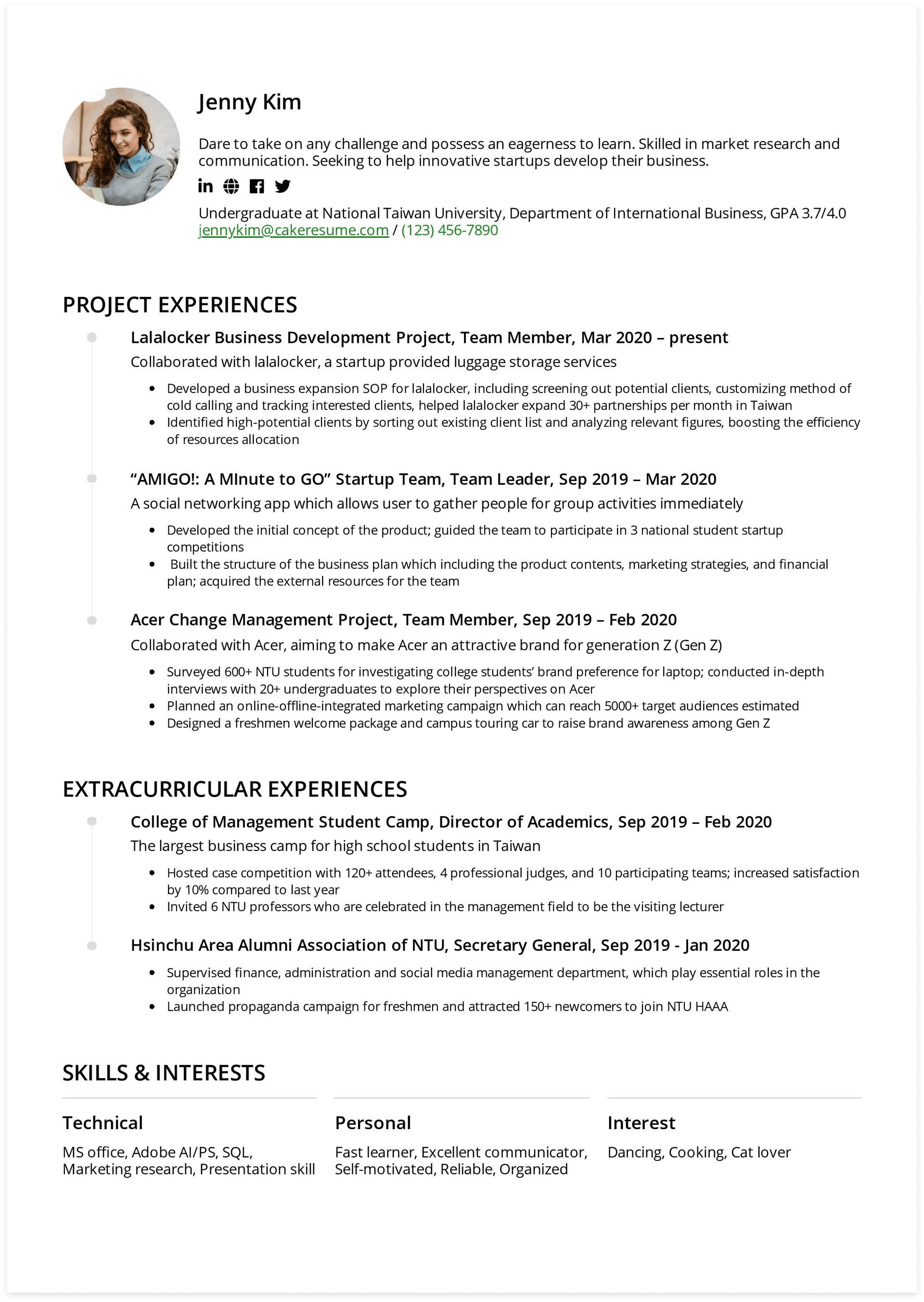
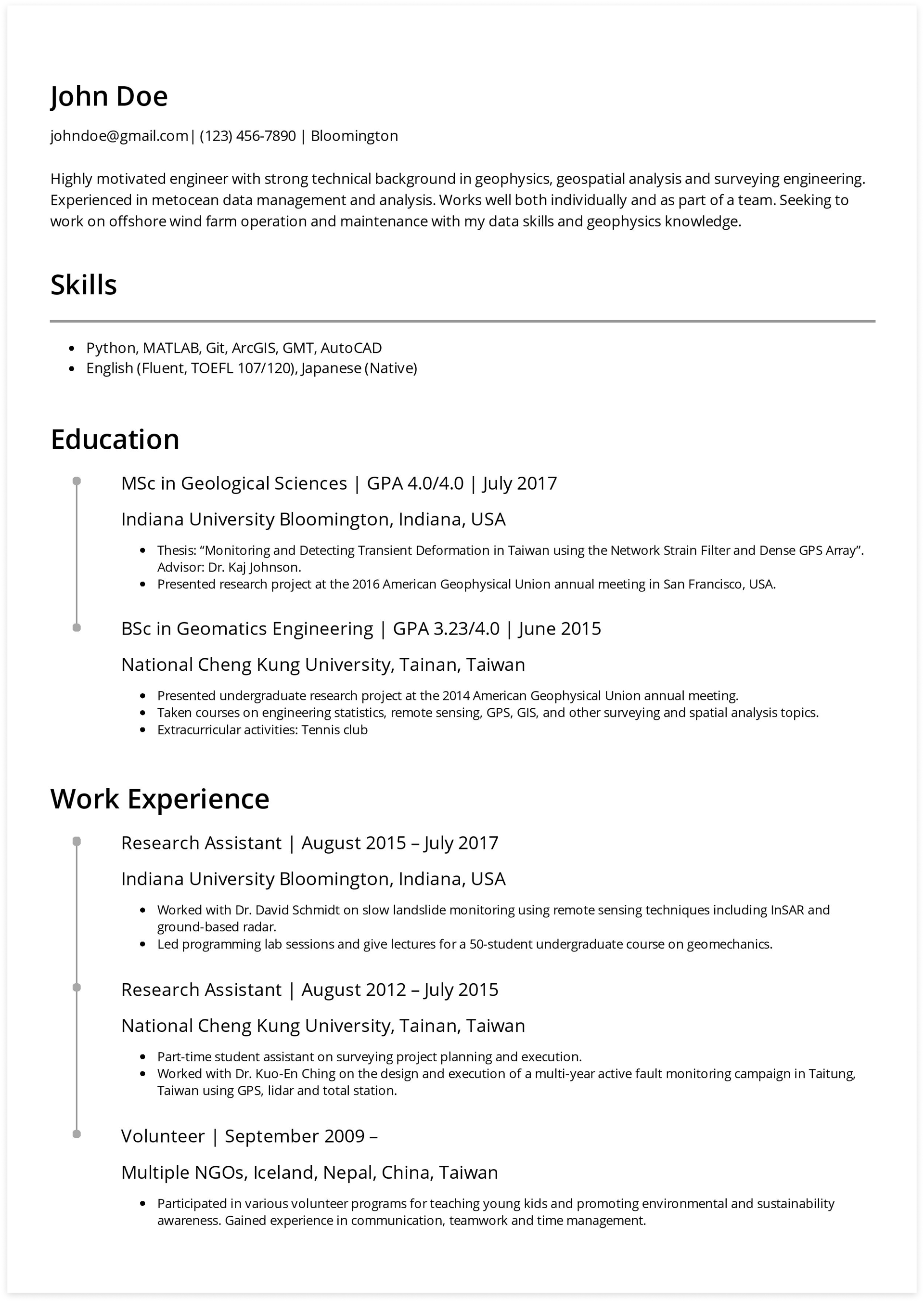
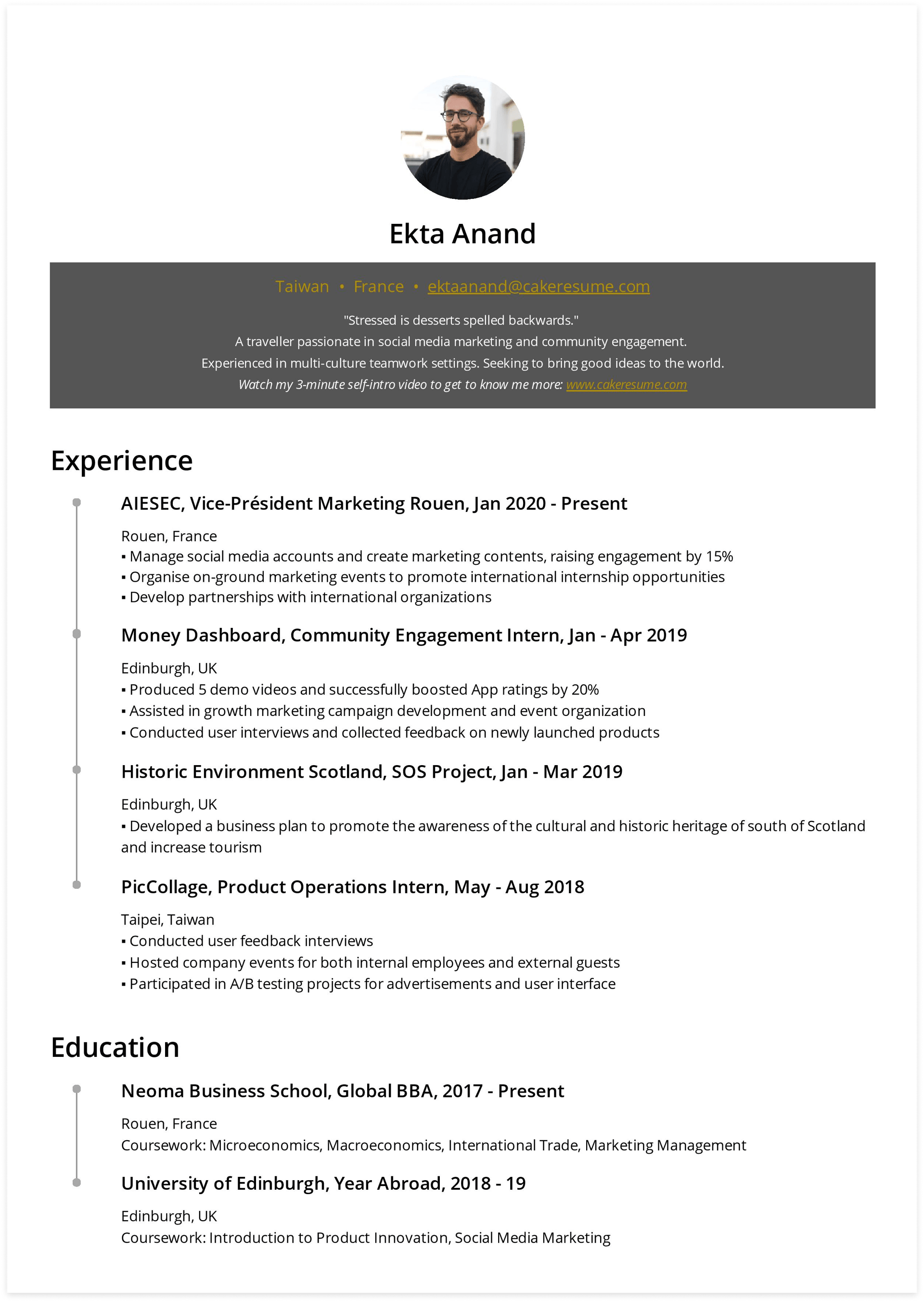
You might have noticed that not all sections are included in each of the resumes above.
That's right! Only choose those that are relevant and show the best of you.
Like the design? Use CakeResume's free resume builder to easily make yourself a stunning resume.
Check out more resume examples on CakeResume!
4 bonus tips for college students
1. Write a convincing cover letter that showcases your motivation. As a student with no full-time work experience, sometimes your personality and motivation are even more valued than hard skills. Try to tell a compelling (and true) personal story that explains your passion.
Further reading: The Cover Letter to Land Your Dream Job:5 Basic Paragraphs & 10 Tips (Free Templates)
2. Have multiple impressive projects? Build an online portfolio. Whether it’s a website or a PDF file, you have the chance to explain your logic and process behind each project, as well as put them in an order that makes sense.
Further reading: What to Include in a Portfolio Resume? 3 Tips to Build a Professional Portfolio for Interview
3. Tailor your resume to the position you’re applying for. Look for specific keywords in the job description or the company website, and try to fit them into your resume. Or, try adjusting the visual design of your resume. For example, adding the company’s brand color to your resume can be a small but appealing move.
4. Proofread, proofread, proofread! You don’t want any typos on your resume. Ask family and friends to double and triple check.
Ready to build your resume? Use our resume builder to quickly and easily build a stunning resume for free!
More Career and Recruitment Resources

Storytelling for social change, inclusive UX designs and gender equity light up my heart. Find me on LinkedIn.


